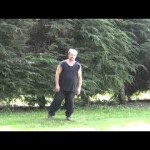 Balance is something that we learn, not something we are born with. Infants try to walk and fall over many times before beginning to walk. The problem is that once we do finally learn how to walk we stop improving our balance. Professional athletes work on improving balance by using regular exercises but most of us get to a certain level, just enough to get around, and stop learning. The fact is however that if you continue to practice, challenging yourself, you can do some truly amazing things. This fact is so evident that the Western medical community has been using Tai Chi and Qigong to treat both Parkinson's disease and elderly patients with amazing results.
Balance is something that we learn, not something we are born with. Infants try to walk and fall over many times before beginning to walk. The problem is that once we do finally learn how to walk we stop improving our balance. Professional athletes work on improving balance by using regular exercises but most of us get to a certain level, just enough to get around, and stop learning. The fact is however that if you continue to practice, challenging yourself, you can do some truly amazing things. This fact is so evident that the Western medical community has been using Tai Chi and Qigong to treat both Parkinson's disease and elderly patients with amazing results.
The reason the success of tai chi in treating patients with balance issues is simply focus. We learn to find our center and focus on our body and its movements on a much deeper level. Exercises begin with teaching students to maintain correct posture and proper standing.
- Stand with shoulders relaxed, arms at your sides, palms facing inward and feet shoulder width apart.
- Beginning at the head, move through each part of your body, focusing on and relaxing any tense area.
The next step is to rediscover your breathing, give it form and substance while you focus on bringing it under your control. The breath is one of the three most important aspects of tai chi and we must first learn that we can control it and use it to our advantage.
- Breathing should move in through the nose and out through the lips, in a slow even rhythm.
- Visualize the breathing as it slowly moves into and of your body. Watch as energy flows into your muscles and organs.
Now that you have learned how to stand properly and are focused on your breathing you can begin to move. One of the best techniques for understanding your central equilibrium is "Empty Leg-Full Leg".
- In the Tai Chi Stance begin to slowly shift your body's onto your right leg, keeping the torso parallel to the ground and using the hips to transfer the weight.
- This will create a stance that leaves all of your bodies weight on one side and a straight line from the top of the head to the bottom of the right foot.
- As the weight leaves the left leg visualize it moving out, give it form, and watch as it fills the right leg. When you are done the left leg should be like a separate part of your body.
- After slowly moving refilling the left l eg with weight you can now move to the other leg and repeat the process.
When we harmonize our breathing and focus with our movements we make a deeper connection with everything around us, allow us to move through the world with a fluidity seldom seen. People who practice tai chi on a regular basis develop what is known as Tai Chi Walk, and is simply a byproduct of learning how to improve balance.
